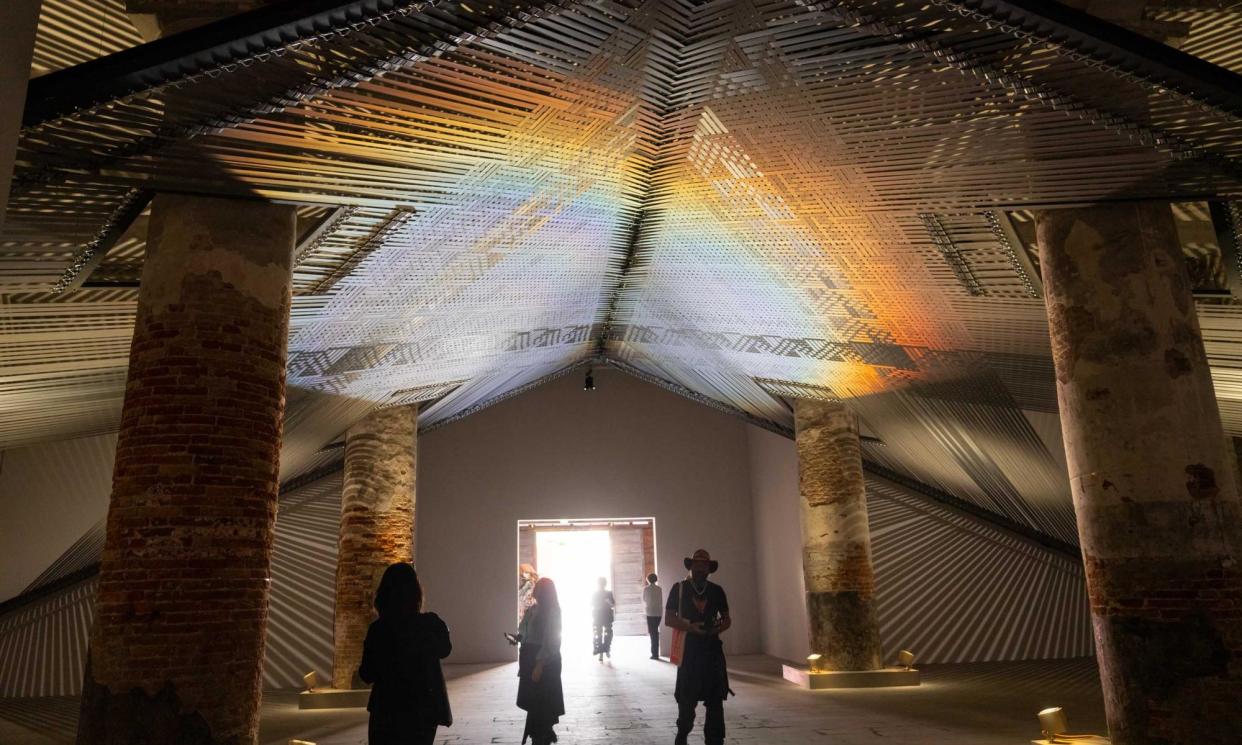‘Luminous’ truck strap artwork wins prestigious Biennale prize in first for New Zealand

A Māori artist collective’s dazzling, intricate canopy woven from reflective trucking straps has been awarded a prestigious global art prize – the first time a New Zealand artwork has won the award.
On Saturday, the jury of the 60th International Art Exhibition of the Venice Biennale awarded New Zealand’s Mataaho Collective the Golden Lion for best international participation for its work Takapau – a large-scale installation inspired by Māori takapau, finely woven mats made for special events.
Indigenous artists from Oceania dominated the awards this year, with Austalia’s Archie Moore winning the Golden Lion for best national participation for his artwork kith and kin, at the Australia Pavilion.
Mataaho collective is made up of four Māori artists: Erena Arapere-Baker, Sarah Hudson, Bridget Reweti and Terri Te Tau, who have worked together on large installations since 2012.
The collective expressed their gratitude for the win in a post to their Instagram page.
“It doesn’t feel like just our award, but recognition of our supportive families, our visionary colleagues, our generous mentors and the Indigenous artists of the future.”
Its winning 200sqm suspended weaving is made from six kilometres of fluorescent trucking straps , 480 stainless steel buckles and ratchets, and 960 J-hooks – safety materials used in labouring jobs and chosen to reflect the artists’ working-class backgrounds.
After the announcement, Mataaho artist Sarah Hudson told RNZ the artists hoped to make gallery spaces more relatable to communities outside the art world.
“We all come from working class whānau [families] and the materials we choose to use are a mihi [tribute] to them, who may not feel at home in the art gallery – we like to use materials they know and experience every day, so they have something to recognise in the art world.”
The Biennale judges picked Takapau out from hundreds of entries for its “impressive scale” and noted that it was a feat of engineering “only made possible by the collective strength and creativity of the group”.
“Mataaho Collective has created a luminous woven structure of straps that poetically crisscross the gallery space,” the judges said in their announcement.
“The dazzling pattern of shadows cast on the walls and floor harks back to ancestral techniques and gestures to future uses of such techniques.”
Caroline Vercoe, associate professor in art history at the University of Auckland, told the Guardian part of the beauty of Mataaho’s work is its ability to work collectively to weave together complex Māori concepts with indigenous art forms and every-day materials.
The Golden Lion award tends to acknowledge something of a “turning point” within certain art practices or thinking, Vercoe said.
“Mataaho and Māori artists are really leading the way with contemporary art practices,” she said.
“We have always known the power of contemporary Māori art and it is just wonderful to see that acknowledged globally.”
Creative New Zealand – the country’s arts funding body – said five Māori artists, including Mataaho Collective, were invited to show at the international exhibition.
Mataaho’s win was a historic moment, said Creative New Zealand’s Amanda Hereaka.
“This award recognises, on the biggest global platform, the importance and relevance of [Māori art] and New Zealand art; we should all celebrate this wonderful achievement.”
New Zealand’s arts, culture and heritage minister, Paul Goldsmith, congratulated the collective for their win.
“This win is a glowing endorsement of the brilliant work of the Mataaho collective and shows, again, our artists are world leaders.”


